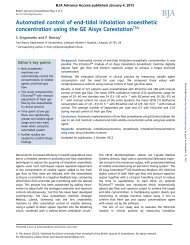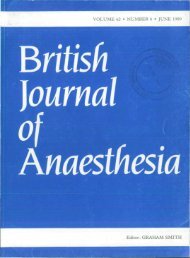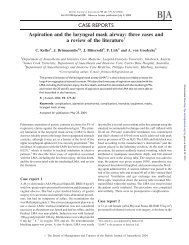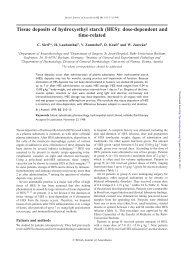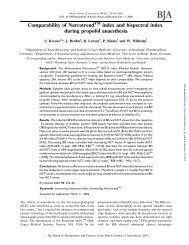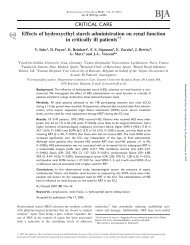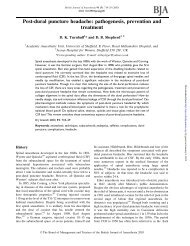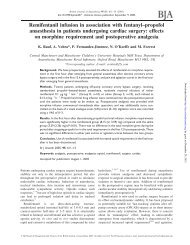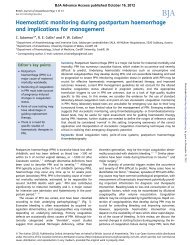Minimal alveolar concentration of sevoflurane for induction of ... - BJA
Minimal alveolar concentration of sevoflurane for induction of ... - BJA
Minimal alveolar concentration of sevoflurane for induction of ... - BJA
Create successful ePaper yourself
Turn your PDF publications into a flip-book with our unique Google optimized e-Paper software.
<strong>BJA</strong><br />
Methods<br />
The study was approved by the local Institute’s Ethical Committee<br />
(Huazhong University <strong>of</strong> Science and Technology) and<br />
registered with ClinicalTrials.gov (ref: NCT01662622). After<br />
written in<strong>for</strong>med consent, we enrolled 31 subjects aged<br />
45–65 yr, undergoing upper abdominal surgery using general<br />
anaesthesia from March to May 2012 at Tongji Hospital,<br />
Tongji Medical College, Huazhong University <strong>of</strong> Science and<br />
Technology, Wuhan, China. All participants had an ASA physical<br />
status classification <strong>of</strong> I or II. Patients were excluded from<br />
the study if they had one <strong>of</strong> the following criteria: any neurological<br />
disease or having received central nervous system–<br />
active drugs; a cardiac ejection fraction ,40%; previous<br />
history <strong>of</strong> difficult intubation or anticipated difficult intubation;<br />
daily alcohol consumption; and obesity (defined as a body<br />
mass index .30 kg m –2 ). Those without in<strong>for</strong>med consent<br />
were also excluded.<br />
As premedication, 0.1 g <strong>of</strong> phenobarbital and 0.5 mg <strong>of</strong> atropine<br />
were administered by i.m. injection. After arrival in the<br />
operating theatre, standard monitoring, including electrocardiography,<br />
non-invasive arterial pressure, and pulse oximetry,<br />
was established. The i.v. infusion rate <strong>of</strong> lactated Ringer’s injection<br />
was 15 ml kg 21 h 21 via an 18 G venous catheter. A neuromuscular<br />
monitor (TOF-watch SX; Organon, Dublin, Ireland)<br />
was placed over the ulnar nerve at the wrist.<br />
Electrical activity <strong>of</strong> the brain was measured and recorded<br />
with a Narcotrend Monitor (unprocessed EEG) and S/5 Compact<br />
Anaesthesia Monitor [burst suppression ratio (BSR)].<br />
Sensors <strong>of</strong> the Narcotrend Monitor (MonitorTechnik, Bad Bramstedt,<br />
Germany, version 4.0) and Entropy Module (S/5 Compact<br />
Anaesthesia Monitor, Datex-Ohmeda, Helsinki, Finland) were<br />
attachedto the <strong>for</strong>ehead <strong>of</strong> each subject according to the manufacturer’s<br />
recommendation. Impedances were measured <strong>for</strong><br />
each set <strong>of</strong> electrodes to ensure adequate electrode contact<br />
defined as 6 kV <strong>for</strong> the Narcotrend Monitor and 7.5 kV <strong>for</strong> the<br />
Entropy Module. To calculate BSR, suppression is defined as<br />
periods .0.5 s during which EEG voltage is ,5 mV. Time in a<br />
suppressed state is measured and BSR is reported as the fraction<br />
<strong>of</strong> the epoch during which the EEG is suppressed. BSR is<br />
averaged over at least 15 epochs (60 s). The presence <strong>of</strong> burst<br />
suppression was defined as BSR .0. 17 A BSR <strong>of</strong> 100% implies<br />
isoelectric EEG.<br />
General anaesthesia was induced by tidal volume breathing<br />
<strong>of</strong> 8% sev<strong>of</strong>lurane in 100% oxygen at 6 litre min 21 with<br />
a semi-closed face mask. Cisatracurium 0.15 mg kg 21 was<br />
administered after loss <strong>of</strong> the lash reflex, 18 with manual ventilation<br />
until the amplitude <strong>of</strong> T1 decreased to zero. Tracheal<br />
intubation was per<strong>for</strong>med and switched to mechanical ventilation<br />
with a fresh gas flow <strong>of</strong> 2 litre min 21 . Oxygen, carbon<br />
dioxide, and sev<strong>of</strong>lurane were sampled with a 19 G tube connected<br />
to the distal end <strong>of</strong> the tracheal catheter. Gas <strong>concentration</strong><br />
and partial pressure were analysed by a gas analyser<br />
(S/5 Compact Anaesthesia Monitor) with a sample flow rate<br />
<strong>of</strong> 200 ml min 21 . The end-tidal partial pressure <strong>of</strong> carbon<br />
dioxide was maintained at 4.7 kPa. An oesophageal temperature<br />
probe was inserted and a warming unit was used if<br />
Niu et al.<br />
necessary to maintain 36.5 to 37.58C. Surgery started at<br />
least 30 min after inhalation <strong>induction</strong>, so that the determined<br />
sev<strong>of</strong>lurane <strong>concentration</strong> was stable <strong>for</strong> at least<br />
15 min and the difference <strong>of</strong> inspired and end-tidal <strong>concentration</strong>s<br />
was ,10%. 4 A cuff-based continuous arterial pressure<br />
monitor was used; an audible alarm was set to indicate<br />
mean arterial pressure (MAP) reduction <strong>of</strong> .20% <strong>of</strong> baseline<br />
values. Phenylephrine 0.1 mg was administered i.v. if necessary<br />
to maintain MAP. Neither Entropy nor Narcotrend<br />
alarms were set.<br />
MAC was determined using the Dixon up-and-down method.<br />
To avoid awareness, the first subject received end-tidal<br />
sev<strong>of</strong>lurane <strong>concentration</strong> <strong>of</strong> 1.7% (1 MAC). As shown in<br />
Figure 1, the presence or absence <strong>of</strong> isoelectric EEG <strong>of</strong> the previous<br />
subject determined the end-tidal sev<strong>of</strong>lurane <strong>concentration</strong><br />
<strong>of</strong> the following subject. End-tidal <strong>concentration</strong> <strong>of</strong><br />
sev<strong>of</strong>lurane <strong>for</strong> the next subject was decreased by 0.2% (isoelectric<br />
EEG) or increased by 0.2% (non-isoelectric EEG). A<br />
crossover response was defined as the consecutive inclusion<br />
<strong>of</strong> a subject who presented isoelectric EEG, followed by<br />
another who did not. The value <strong>of</strong> a pair was the average <strong>of</strong><br />
the end-tidal <strong>concentration</strong> used <strong>for</strong> the two subjects <strong>of</strong> this<br />
pair. The MACie was determined by averaging the values <strong>of</strong><br />
six consecutive pairs. For each subject, a 30 min interval was<br />
given to allow equilibration between arterial and brain tensions.<br />
2 The isoelectric EEG was considered as significant<br />
when the isoelectric state lasted .1 min. 19 The maximal BSR<br />
was recorded if isoelectric EEG was not reached. Then, the endtidal<br />
<strong>concentration</strong> <strong>of</strong> sev<strong>of</strong>lurane was maintained until 3 min<br />
after incision. Heart rate (HR) and MAP were recorded at 2 and 1<br />
min be<strong>for</strong>e skin incision, and then at 3 min after surgical incision.<br />
The pre-incision value was defined as the mean value <strong>of</strong><br />
the 2 and 1 min be<strong>for</strong>e skin incision. Adrenergic reflexes (an increase<br />
in either HR or MAP .15% above the pre-incision<br />
values) 5 cases were counted.<br />
Statistical analysis<br />
Patient characteristic data were collected and presented as<br />
mean (SD) or as number (%) where appropriate. The MACie<br />
was calculated as the mean <strong>of</strong> six independent crossovers <strong>of</strong><br />
end-tidal sev<strong>of</strong>lurane <strong>concentration</strong> as shown in Figure 3.<br />
Up-and-down sequences were analysed by the probit test<br />
(SPSS <strong>for</strong> Windows 12.0; SPSS, Inc., Chicago, IL, USA), which<br />
enabled MACie and MACbs with 95% confidence limits <strong>of</strong> the<br />
mean to be derived. 20 Data were also analysed with logistic<br />
regression <strong>for</strong> the probability <strong>of</strong> isoelectric EEG and burst suppression<br />
vs end-tidal <strong>concentration</strong>, the maximum-likelihood<br />
estimation, and goodness-<strong>of</strong>-fit.<br />
Subjects were divided into an isoelectric EEG (ie+) group<br />
and a non-isoelectric EEG (ie2) group. The frequency <strong>of</strong><br />
phenylephrine injection and incidence <strong>of</strong> positive adrenergic<br />
reflexes were compared between groups by two-tailed<br />
Fisher’s exact test. Numerical data were analysed by Student’s<br />
t-test or the Mann–Whitney U-tests where appropriate.<br />
P-values <strong>of</strong> ,0.05 were considered statistically significant.<br />
Downloaded from http://bja.ox<strong>for</strong>djournals.org/ by guest on January 21, 2014<br />
Page 2 <strong>of</strong> 7




